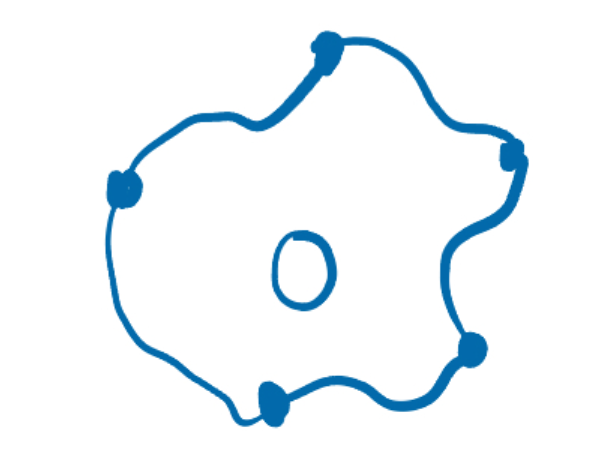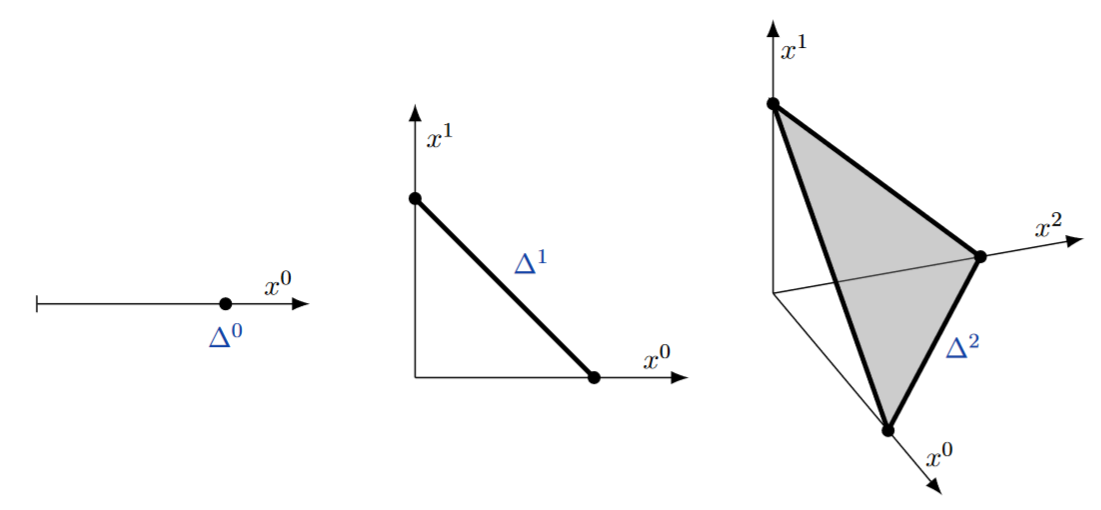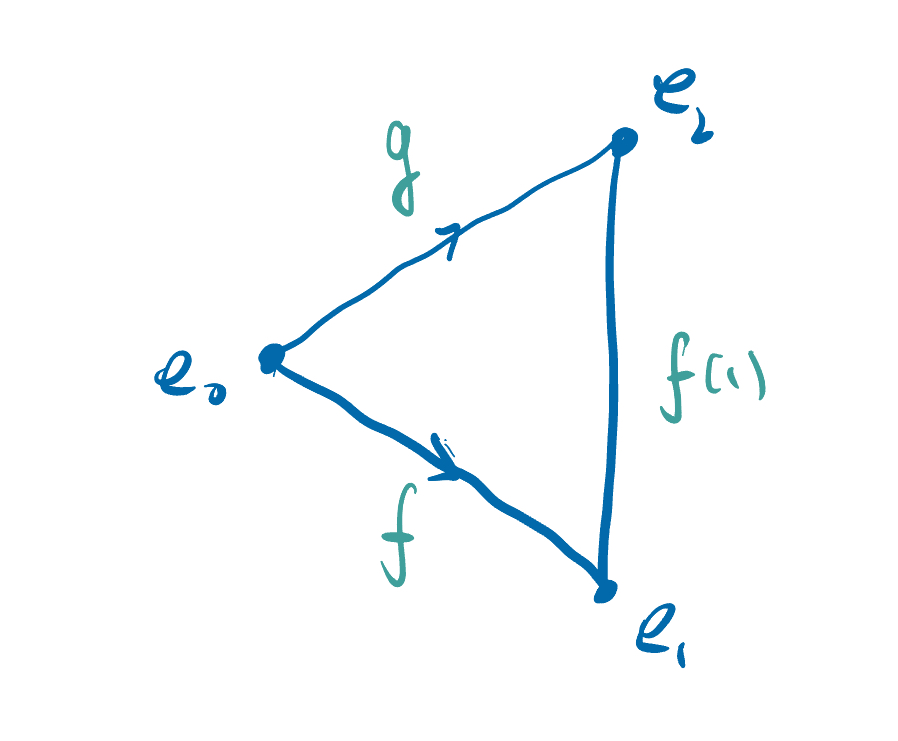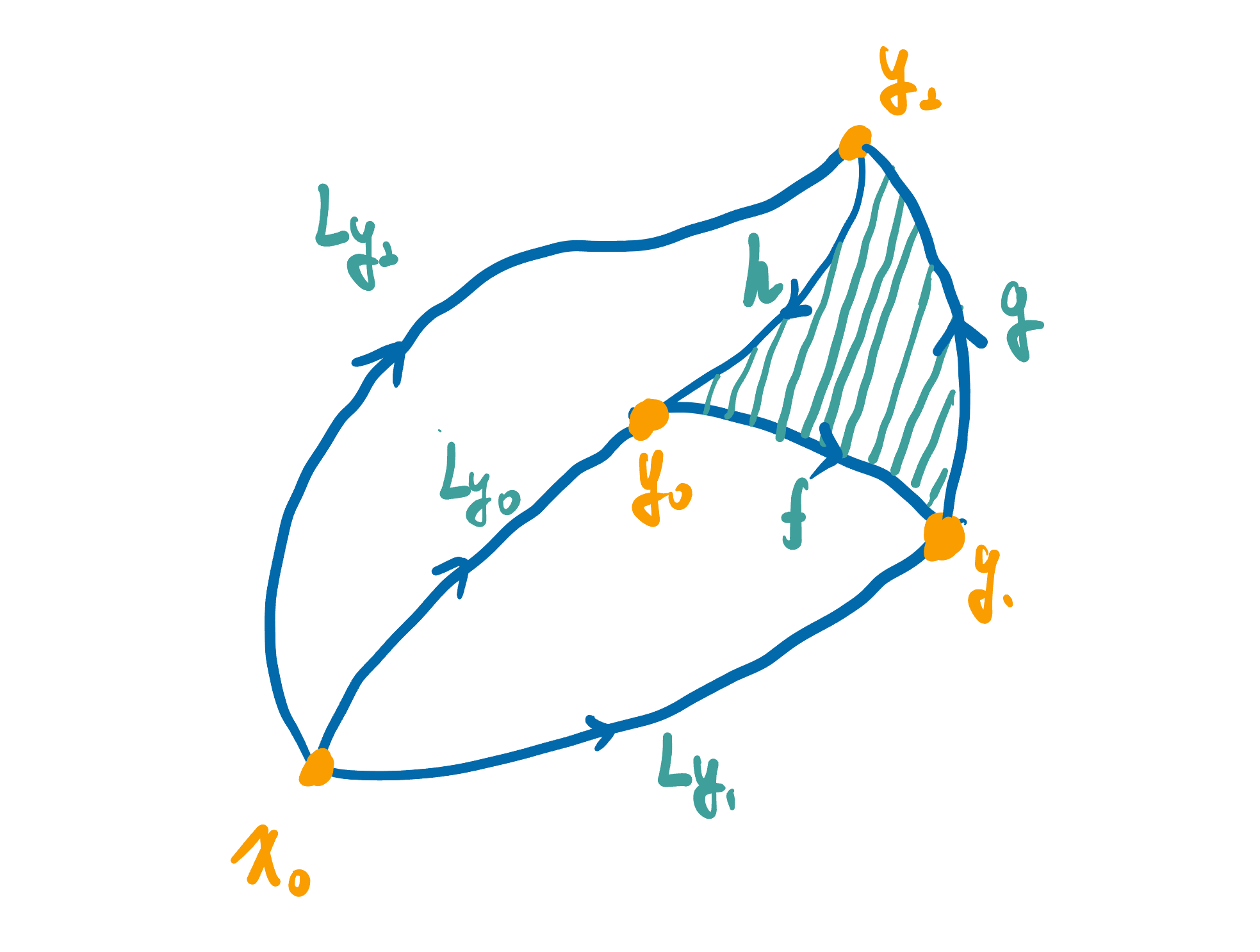This document is a seminar note on singular homology.
Before reading this article, make sure you have known the Chapter 1-3 of An Introduction to Algebraic Topology, written by Rotman.
You can download the pdf version from this link.
Reference
- An Introduction to Algebraic Topology, Rotman
- Topology and Geometry, Bredon
- 代数学方法 卷一:基础架构, 李文威
- nlab
Why should we learn homology?
When we use calculus to solve physical problems, we often encounter functions like
where
It can be noticed that
Homology was initially defined as closed curves or surfaces with the same integral values, but this definition cannot adapt to general topological spaces. From a geometric intuition, a hole should be a type of topological invariant that remains unchanged under homeomorphism. Therefore, we need to find some new methods to define homology, and thereby study the properties of these holes. Next, we will begin to learn a definition method of homology, which is the singular homology.
1. Definition of Singular Homology
Let's begin with some basic definitions.
1.1 Definition.
Let
be a set and . We can define a binary operation
It's easy to check that
is an abelian group. And we call it the free abelian group on . We usually denote
as . For example, we can use
to denote We also use
to denote the free abelian group on .
The free abelian group has a universal property.
1.2 Theorem (Universal Property).
Let
be a set and be the free abelian group on it.
is an abelian group and there is a function . Then there exists a unique group homomorphism making diagram commute, where
is the inclusion. And is called extending by linearity. Proof.
Define
. It's easy to check that is a group homomorphism. Then let's prove
is unique. Let
is another function fit the theorem. Then we have Therefore,
and is unique.
1.3 Definition.
For
, the standard -simplex is We can see their graphs in this picture:
We can denote
as , where are vertices of . Sometimes, we will see
as with .
When we perform integrations on some geometric shapes, these shapes often have an orientation. Similarly, we can also define an orientation for simplices.
1.4 Definition.
An orientation of
is a linear ordering of its vertices. An orientation thus gives a tour of the vertices. For example, the orientation
of gives a counterclockwise tour. Two orientations of
are the same if, as permutations of , they have the same parity (i.e., both are even or both are odd); otherwise the orientations are opposite.
1.5 Definition.
Let
be a topological space, . A (singular) -simplex in is a continuous function .
denotes the free abelian group generated by all singular -simplices in ; and we define for all integers . And we call an element in
is an -chain on .
Let's consider what the elements in
Let
How to use
When X is a plane with some holes, we can notice that the holes in the plane can be surrounded by a 1-chain, whose simplices precisely form some "closed curves".

Therefore, we need a method to find "closed curves" and try to use them to describe holes.
As we can see, "closed curves" have no boundary while "open curves" always have at least two points as its boundary.

Thus, we need to describe the boundary of an
1.6 Definition.
Define the
-th face map of
We can consider that the usage of these maps is to take out the face opposite to the
1.7 Definition.
If
is continuous and , then its boundary is if
, define . As shown in the following figure, defining the boundary in this way is consistent with our geometric intuition.
Then we extend
by linearity, and hence we get a group homomorphism , for all . The homomorphisms are called boundary operators. Strictly speaking, we ought to write
instead of since these homomorphisms do depend on ; however, this is rarely done. For each
, we have constructed a sequence of free abelia groups and homomorphisms , called the singular complex of
; it is denoted by or, more simply, by .
Then, we can find all "closed curves".
1.8 Definition.
The group of (singular)
-cycles in , denoted by , is .
Although we can find all "closed curves" in a plane

Therefore, we know that there are some "closed curves", boundaries of
1.9 Definition.
The group of (singular)
-boundaries in , denoted by , is .
Wait, are
1.10 Lemma.
If
, the face maps satisfy It's easy to prove by using the definition of
.
1.11 Theorem.
For all
, we have ; and thus . Proof.
Since
is generated by all -simplices , it suffices to show that for each such .
Eventually, we can describe holes by using the quotient group.
1.12 Definition.
For each
, the -th (singular) homology group of a space is The coset
, where is an -cycle, is called the homology class of , and it is denoted by .
2. Functorialities of
When we view
2.1 Definition.
A (chain) complex is a sequence of abelian groups and homomorphisms
, where
, such that for each . The homomorphism is called the differentiation of degree , and is called the term of degree . The complex above is denoted by
or, more simply, by .
2.2 Definition.
If
and are complexes, a chain map is a sequence of homomorphisms such that the diagram commutes.
2.3 Theorem.
All complexes and chain maps form a category, denoted by
, when one defines composition of chain maps coordinatewise: . It's easy to prove this is a category.
2.4 Theorem.
Let
be a continuous function and , where and is an -simplex for all . Define , and then we get a sequence of homomorphisms . (Note: does depend on , but we usually don't give it a subscript.) Define
. And then are functors. Proof.
Let
and are continuous functions. Then, for any -simplex in , we have By the universal property of free abelian groups, we have
. Let
be the identity map of . Then, for any -simplex in , we have Similarly, because of the universal property of free abelian groups, we have
. Consequently,
is a functor. Next, to check
is a functor, we need to verity the commutation of diagram ; for any
-simplices in , we have
2.5 Definition.
Let
be a chain complex. Then, there are Similarly,
is called the group of -cycles, is called the group of -boundaries, and is called -th homology group. Let
be a chain map. Define We also denote
as . If is continuous. We denote as , too.
2.6 Theorem.
is a functor. And thus, the composition
is also a functor. We always write as . Proof.
Let
be chain complexes, and be chain maps. Then we have
and
Therefore,
is a functor.
2.7 Lemma.
Let
be a subspace of with inclusion . Then is an injection for every . Proof.
Let
, where are distinct -simplices. Then we have
. Since
, we have are distinct. Therefore, for each , .
Recall: Coproduct
Let
Then the coproduct is an object
commute.
Coproduct is a specific example of colimits (direct limits). Next, I will show you that
2.8 Lemma.
Functor
preserve coproduct; that is is a set of topological spaces and let , and then we have . Proof.
Let
be inclusions. It's sufficient to prove
has the same universal property as ; that is, for all complexes and chain maps , there is a unique chain map such that the diagrams commute.
Existence of
: For each
-simplex , since is path connected, there is a such that . Therefore, for each
with are -simplices, we have , where . Define
It's easy to know
are group homomorphisms. We should show that is a chain map. For
and are chain maps, we have commutative diagrams and
; hence
Uniqueness of
: If there are
and both satisfy the properties, then we have Therefore,
.
2.9 Theorem.
Functor
preserve coproduct; that is is a set of chain complexes, and then we have . Proof.
Let
and be inclusions. It's sufficient to prove
has the same universal property as ; that is, for all abelian groups and homomorphisms , there is a unique homomorphism , such that the diagrams commute.
- Existence of
: Each
, where , can be write as with . Define
Next, let's show that
is well-defined. Let
, and then there is with . Because of the commutative diagram
, we have
Thus,
. Consequently, we have
; hence .
- Uniqueness of
: If there are
and both satisfy the properties, then we have Therefore,
.
2.10 Corollary.
If
is the set of path components of , then we have
3. Dimension Axiom and Homotopy Axiom
In this section, we will introduce two axioms of homoblogy theory.
3.1 Theorem (Dimension Axiom).
If
is a one-point space, then for all . Proof.
For each
, there is only one singular -simplex , where is a constant map. Therefore,
. Then, let's compute the boundary operators: It follows that, for all
, Thus, for each
,we have two conditions:
- If
is odd, we have and . Hence, . - If
is even, we have . Therefore,
.
3.2 Definition.
A space
is called acyclic if for all .
3.3 Proposition.
- If
, then for all . - If
is a one-point space, then . - If
is the Cantor set, then
3.4 Theorem.
If
is a non-empty path-connected space, then . Hence, for any topological space
, , where are path components of . Proof.
For
, we have . (We will use
to denote the map .) Define
. It's obvious that is a subgroup of . Next, let's prove
.
If
, then there is with . And then, we have
. Since
are generators, . Therefore,
. Let
, and fix a point . Let
be a path from to (consider as ). Then let
. We can find that Therefore,
. Define
. It's trivial that is a homomorphism with . Consequently,
.
Next, we will learn the homotopy axiom; that is if
3.5 Lemma.
If
be a bounded convex subset of , then for all . Proof.
Fix a point
. Let be a -simplex. For all
, define And then define
It's easy to check
is a homomorphism. When
, we claim that, for a -chain , If
is true, we have, for all , Consequently,
; hence, the lemma has been proved. Next, we will prove
. Let
be a -simplex. And then we have ; and
Thus, we have
. By using the universal property of free abelian groups, we proved
.
3.6 Definition.
Let
be two chain complexes, and and be chain maps. We call and are (chain) homotopic if there are homomorphisms such that for each . The following diagram is NOT commutative.
3.7 Theorem.
If
and are chain homotopic, then we have for each . Proof.
Let
, and then we have
3.8 Lemma.
Let
be a space and, for , define Let
be two homotopic continuous maps. If
, then we have . Proof.
Let
be the homotopy. Then we have
3.9 Definition.
Let
be two categories, and be two (covariant) functors. A natural transformation is a collection of morphisms such that the diagrams commute.
3.10 Theorem (Homotopy Axiom).
If
be two homotopic continuous maps, then Notations:
Let
are maps. Define Let
is a map. Define Proof.
As what we discussed above (3.5, 3.6 and 3.7), it's sufficient to prove
and are chain homotopic. Define
, and , where is a continuous map. It's easy to check
is a functor. Actually, we will construct natural transformations
such that Since
is a natural transformation, we also have a commutative diagram . Let
be the identity map and be a -simplex on . (We will use in short for in the remaining part of this proof.) If
exists, we can notice that Therefore, in order to construct
, we only need to construct . Next, let's construct
by induction on .
Base step for induction (
): We have
for only has one homomorphism. Let
be the identity map. Define
and, for
-simplex , By extending
by linearity, we get homomorphisms . Then we should verify the inductive hypothesis.
For
-simplex , we have Consequently,
And by the universal property of the abelian groups, we know
is true. (Naturality of
) Let
be a continuous map. Then we have Similarly, by the universal property, we know
is a natural transformation. Assume that
. Let
be the identity map. If
is true, we have Therefore, we need to prove
. Since
is a bounded convex subset of , by lemma 3.4, we have ; that is . Consequently, we only need to prove
. Since
we have
; that is , such that . Define
and
By extending
by linearity, we get homomorphisms . Next, we need to verify inductive hypothesis.
For
-simplex , we have And by the universal property of the abelian groups, we know
is true. (Naturality of
) Let
be a continuous map. Then we have Similarly, by the universal property, we know
is a natural transformation.
Therefore, we can also see
3.11 Corollary.
If
and have the same homotopic type, then we have .
3.12 Corollary.
If
is contractible, then for all , and .
4. Hurewicz Theorem
In this section, let's talk about the relationship between
We will denote the abelianized fundamental group of
We will use
4.1 Lemma.
If
and are paths in such that then the -chain is a boundary. Proof.
Define a continuous map
as indicated by the following picture. In more detail, first define
on : Now define
on all of by setting it constant on the line segment with endpoints and , and constant on the line segments with endpoints and . Then we can find that
.
4.2 Lemma.
If
is a constant, then is a boundary. Proof.
By lemma 3.1, we have
is a boundary.
4.3 Lemma.
If
and are paths with , then . And thus
is a boundary; hence, is a boundary by lemma 3.2. Proof.
Let
be the homotopy. Define
The definition of this map is illustrated in the following picture.
Then, it's obvious that
, where is a constant map. Therefore, by lemma 3.2,
.
4.4 Definition.
The Hurewicz map is
By lemma 4.1, 4.2 and 4.3, we can know that
is a well-defined homomorphism.
As we can see,
In fact,
To prove
Since
For each
Then by extending
To ensure
4.5 Lemma.
The map
takes the group into . Proof.
Let
be a -simplex. Let for and . Then
For
is a boundary of -simplex, which is nullhomotopic rel (Rotman, Exercise 3.4), . Therefore, by the universal property of the abelian group, we get
.
Consequently,
If
Thus, to show
4.6 Lemma.
If
is a -cycle, then . Proof.
Let
, where are -simplices. Then we have
; hence . Therefore, by lemma 4.1-4.3, we have
Finally, we proved the Hurewicz theorem.
4.7 Theorem (Hurewicz).
If
is a path-connected space with base point , then Proof.
From what we talked above,
is the isomorphism.
4.8 Corollay.
. - If
is simply connected, then .
4.9 Theorem.
Let
be the Hurewicz map. Then
is a natural transformation from to ; that is the diagram commutes, for each continuous map
. Proof.
If
be a loop in with base point , then $$$$





